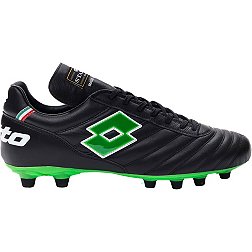How to Choose Soccer Cleats for Your Game
Your soccer cleats are a key part of your game, so keep in mind these factors before making your selection:
Uppers: Your soccer cleats should be built with an air-light leather or synthetic upper, and it's crucial that your upper provides both playability and durability on the pitch. A low-profile, glove-like fit ensures you'll maintain optimal ball feel during play.
Breathability: For added airflow, try leather cleats with perforated or mesh paneling. Synthetic upper cleats are great for new players and generally perform well in most playing situations.
Traction: The latest cleats for grass and soft playing surfaces are designed to bite into ground for traction and speed, while molded rubber or plastic cleats provide maximum versatility when playing conditions are unpredictable.
Indoor Soccer Shoes: When the game brings you indoors, go for a soccer shoe with an outsole pattern designed for multidirectional footwork.
Cleat Types: Molded cleats are a basic soccer shoe component. These non-removable plastic or rubber studs can be used to provide traction and control on a variety of playing surfaces and field conditions. They're great for beginner or novice players. Detachable cleats can be screwed on and off the outsole of your soccer shoes. Players can better customize their shoe to playing conditions and field surfaces with this type of cleat. They are ideal for experienced players or those who frequently take to wet, soggy fields or finely groomed grass. Pro Tip: Check with your local league to see what type of surface you'll be playing on and if there are any restrictions on cleat types.
Soccer Cleat Colors: Find soccer cleats that showcase your style or find a pair that matches your team colors. Choose from classic black soccer cleats and white soccer cleats, or find a variety of colorful soccer cleat options including blue soccer cleats, red soccer cleats, purple soccer cleats and pink soccer cleats.
Soccer Cleat Brands: Shop the latest innovative soccer cleat styles from top brands like Nike, PUMA, adidas, New Balance, Charly, Lotto, Under Armour, IDA Sports and more.
Soccer Cleats for Each Position: Choose soccer cleats that will be a comfortable fit for your role on the field. Forwards and midfield players will likely want the extended range of motion of cleats with a low ankle height, while defenders may want the added protection of cleats with a mid ankle height.
Soccer Cleat Tips
Alternating Cleats: Consider alternating between two pairs of soccer cleats for practice and games. Although this is an additional upfront investment, alternating between pairs could provide multiple seasons of use.
Break In Your Cleats: If you've just purchased a new pair of soccer cleats, try to break them in during a few practices before you wear them in a game.
Offseason Cleat Care: Store your soccer cleats in a breathable bag away from direct sunlight during the offseason to keep them in good shape.
Taking Off Cleats: Take off your cleats by untying the laces. Stepping on the back of the heel or prying off your cleats without untying them can cause unnecessary wear and damage.
Find the right fit: Soccer cleats that are too roomy or too tight may cause blisters and hinder your play. Be sure to find a comfortable fit before hitting the field, and keep in mind that younger players that are still growing may need new cleats every season.
Looking for something else? Check out our soccer balls collection, top-rated Messi soccer cleats, other soccer shoes or shop all shoes & footwear at DICK'S Sporting Goods.





























































